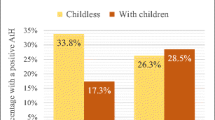Abstract
The current investigation, following Bobrow and Bailey (2001), aimed to test the kin selection theory of homosexuality in human males using a survey design. A total of 60 heterosexual and 60 homosexual men from England completed items measuring psychological and behavioral indices of “special design” as predicted by adaptation due to kin selection. There were no significant differences between heterosexual and homosexual men in general familial affinity, generous feelings (willingness to provide financial and emotional resources), and benevolent tendencies (such as willingness to baby-sit). These remained non-significant after co-varying for level of personal income (higher among homosexual men), psychological gender, and interest in children. Overall, little support was found for the kin selection theory in a community sample.
Similar content being viewed by others
References
Bailey, J. M. (2003). The man who would be queen. Washington, DC: Joseph Henry Press.
Bailey, J. M., Dunne, M. P., & Martin, N. G. (2000). Genetic and environmental influences on sexual orientation and its correlates in an Australian twin sample. Journal of Personality and Social Psychology, 78, 524–536.
Berglin, C. G. (1982). Birth order as a quantitative expression of date of birth. Journal of Epidemiology and Community Health, 36, 298–302.
Bell, A. P., & Weinberg, M. (1978). Homosexualities: A study of diversity among men and women. New York: Simon & Schuster.
Blanchard, R. (1997). Birth order and sibling sex ratio in homosexual versus heterosexual males and females. Annual Review of Sex Research, 8, 27–67.
Bobrow, D., & Bailey, J. M. (2001). Is male homosexuality maintained via kin selection? Evolution and Human Behavior, 22, 361–368.
Buss, D. (1994). The evolution of desire: Strategies in human mating. New York: Basic Books.
Dickemann, M. (1995). Wilson’s panchreston: the inclusive fitness hypothesis of sociobiology re-examined. In J. P. DeCecco & D. A. Parker (Eds.), Sex, cells, and same-sex desire: The biology of sexual preference (pp. 147–183). New York: Haworth Press.
Eysenck, H. J., Wilson, G. D., & Jackson, C. (1996). Eysenck personality profiler. Croydon, Surrey: PSI Press.
Hamer, D., & Copeland, P. (1994). The science of desire: The search for the gay gene and the biology of behavior. New York: Simon & Schuster.
Hamer, D. H., Hu, S., Magnuson, V. L., Hu, N., & Pattatucci, A. M. L. (1993). A linkage between DNA markers on the X chromosome and male sexual orientation. Science, 261, 321–327.
Hu, S., Pattatucci, A. M. L., Patterson, C., Li, L., Fulker, D. W., Cherny, S. S., et al. (1995). Linkage between sexual orientation and chromosome Xq28 in males but not in females. Nature Genetics, 11, 248–256.
Kinsey, A. C., Pomeroy, W. B., & Martin, C. E. (1948). Sexual behavior in the human male. Philadelphia: Saunders.
Kirkpatrick, R. C. (2000). The evolution of homosexual behavior. Current Anthropology, 41, 385–413.
Lippa, R. A. (2000). Gender related traits in gay men, lesbian women, and heterosexual men and women: The virtual identity of homosexual-heterosexual diagnosticity and gender diagnosticity. Journal of Personality, 68, 899–926.
Lippa, R. A. (2002). Gender-related traits of heterosexual and homosexual men and women. Archives of Sexual Behavior, 31, 83–98.
McKnight, J. (1997). Straight science? Homosexuality, evolution and adaptation. London: Routledge.
Muscarella, F. (2000). The evolution of homoerotic behavior in humans. Journal of Homosexuality, 40, 51–77.
Rahman, Q., & Wilson, G. D. (2003). Born gay? The psychobiology of human sexual orientation. Personality and Individual Differences, 34, 1337–1382.
Rice, G., Anderson, C., Risch, N., & Ebers, G. (1999). Male homosexuality: Absence of linkage to micro-satellite markers at Xq28. Science, 284, 665–667.
Ruse, M. (1982). Are there gay genes? Sociobiology and homosexuality. Journal of Homosexuality, 6, 5–34.
Saghir, M. T., & Robins, E. (1973). Male and female homosexuality: A comprehensive investigation. Baltimore, MD: Williams & Wilkins.
Salais, D., & Fischer, R. B. (1995). Sexual preference and altruism. Journal of Homosexuality, 28, 185–196.
Weinrich, J. D. (1976). Human reproductive strategy: II. Homosexuality and non-reproductive strategy: Some evolutionary models. Unpublished doctoral dissertation, Harvard University.
Wilson, E. O. (1975). Sociobiology: The new synthesis. Cambridge, MA: Belknap.
Wilson, E. O. (1978). On human nature. Cambridge, MA: Harvard University Press.
Author information
Authors and Affiliations
Corresponding author
Rights and permissions
About this article
Cite this article
Rahman, Q., Hull, M.S. An Empirical Test of the Kin Selection Hypothesis for Male Homosexuality. Arch Sex Behav 34, 461–467 (2005). https://doi.org/10.1007/s10508-005-4345-6
Issue Date:
DOI: https://doi.org/10.1007/s10508-005-4345-6




